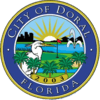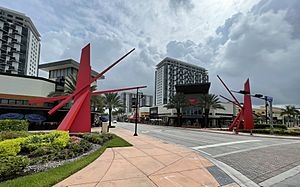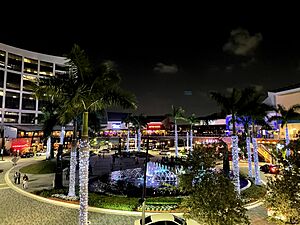Doral, Florida facts for kids
Quick facts for kids
Doral, Florida
|
|||
|---|---|---|---|

Downtown Doral
|
|||
|
|||
| Motto(s):
"Live, Work, Learn and Play!"
|
|||

Location in Miami-Dade County and the state of Florida
|
|||
| Country | |||
| State | |||
| County | Miami-Dade | ||
| Incorporated | June 24, 2003 | ||
| Government | |||
| • Type | Council-Manager | ||
| Area | |||
| • Total | 15.08 sq mi (39.05 km2) | ||
| • Land | 13.83 sq mi (35.83 km2) | ||
| • Water | 1.24 sq mi (3.22 km2) 3.52% | ||
| Elevation | 3 ft (1 m) | ||
| Population
(2020)
|
|||
| • Total | 75,874 | ||
| • Density | 5,484.60/sq mi (2,117.64/km2) | ||
| Time zone | UTC−5 (EST) | ||
| • Summer (DST) | UTC−4 (EDT) | ||
| ZIP Codes |
33122, 33166, 33172, 33178
|
||
| Area code(s) | 305, 786, 645 | ||
| FIPS code | 12-17935 | ||
| GNIS feature ID | 1867137 | ||
Doral is a city in Miami-Dade County, Florida, United States. It's one of 34 cities in the county. Doral is about 5 miles (8 km) west of Miami International Airport. It's also about 13 miles (21 km) west of Downtown Miami.
The city covers about 15 square miles (39 square kilometers). It has borders like the Ronald Reagan Turnpike to the west. The Florida Everglades are also to its west. To the north is the town of Medley. The Palmetto Expressway is to the east. The Dolphin Expressway and the city of Sweetwater are to the south. Doral is part of the larger Miami metropolitan area in South Florida.
In 2020, Doral had a population of 75,874 people. This was a big jump from 45,704 people in 2010. Doral is run by a mayor-council-manager government. This means a mayor and four council members make the laws. They also approve the city's budget. A city manager then carries out their plans.
Doral is known for its many shops and businesses. It has many companies that import and export goods. This is because it's very close to the airport. In 2008, Fortune Small Business and CNN Money said Doral was one of the top 100 cities. It was praised for its good business environment and fun lifestyle. In 2018, Money magazine called it one of the Best Places to Live.
Contents
History of Doral
In the late 1950s, two people named Alfred and Doris Kaskel bought a large area of swampland. It was about 2,400 acres (9.7 sq km) and cost around $49,000. They planned to build a golf course and a hotel there. In 1962, the Doral Country Club opened. It had golf courses and a hotel. The name "Doral" comes from combining Doris and Alfred's names.
The Doral Hotel and Country Club quickly became a popular spot. Guests would travel from Miami Beach to play golf. In its second year, the Kaskels hosted the first Doral Open Invitational. This was a major golf event for the PGA in Florida. Alfred offered $50,000 in prize money. This helped attract famous golfers to the course.
In the early 1980s, Doral started to grow with more homes. Alfred and Doris' grandson, Bill, built Doral Estates. Then, with Lennar, they built Doral Park. Both communities were named after the hotel. Many young families moved to the area. But there were no stores, schools, or parks at first.
From 1983 to 1985, new building was stopped to protect water wells. After this ban was lifted, Doral grew very fast. In 1989, Morgan Levy helped start a group called the West Dade Federation of Homeowner Associations. They worked to improve the community. They helped get a police station built. They also pushed for better roads, lighting, and landscaping.
By 1995, residents wanted Doral to become its own city. They felt their taxes were too high for the services they got. They also wanted more control over growth. After a long effort, the community elected its first council in 1996.
In January 2003, Doral voters decided to become a city. About 85% of people voted yes. In June of the same year, 92% voted to accept the city's rules. They also elected their first Mayor and City Council.
The new City of Doral became a good place for businesses. Especially those interested in the Latin America market. In 2012, Luigi Boria became the second Venezuelan-American mayor in the U.S. He was followed by Juan Carlos Bermudez, who won in 2016 and 2020. On December 13, 2022, Christi Fraga was elected. She became Doral's first female Mayor.
Media and News
Doral has local newspapers like Doral Community Newspapers. It also has the Doral Family Journal.
Two large media companies have their main offices in Doral. These are Univision Network and CBS-owned WFOR-TV, Channel 4. Many other TV studios and operations are also in Doral. The Telemundo network has one of its main offices and production units here.
Geography and Climate
Doral is located at about 25.8 degrees North latitude and 80.35 degrees West longitude. The city has a total area of about 15.08 square miles (39.05 sq km). Most of this is land, about 13.85 square miles (35.83 sq km). The rest, about 1.23 square miles (3.22 sq km), is water.
Surrounding Areas
Doral is surrounded by other places in Miami-Dade County, Florida.
- To the north is the Town of Medley and Hialeah.
- To the west is unincorporated Miami-Dade County and Tamiami.
- To the east are Miami Springs and Fontainebleau.
- To the south are Tamiami and West Miami.
Climate
Doral has a tropical monsoon climate. This means it has hot and humid summers. The heat index often goes above 100 °F (37°C). The rainy season is from May to October. Most of the city's rain falls during these months. Winters are short, dry, and warm. Sometimes, temperatures drop when cold fronts pass through.
Population Facts
Doral has grown a lot over the years.
| Historical demographics | 2020 | 2010 |
|---|---|---|
| White (Non-Hispanic) | 9.8% | 14.6% |
| Hispanic | 83.0% | 79.5% |
| Black or African American (Non-Hispanic) | 1.1% | 1.6% |
| Asian and Pacific Islander (Non-Hispanic) | 2.9% | 3.4% |
| Native American (Non-Hispanic) | 0.1% | < 0.1% |
| Some other race (Non-Hispanic) | 0.7% | 0.3% |
| Two or more races (Non-Hispanic) | 2.5% | 0.5% |
| Population | 75,874 | 45,704 |
In 2020, there were 75,874 people living in Doral. There were 18,791 households and 15,311 families. In 2010, there were 45,704 people. There were 13,462 households and 10,583 families.
Economy and Businesses
In 2005, Doral had over 10,000 businesses. Companies like Carnival Cruise Lines, Ryder, and Univision had offices there. Doral has always attracted many businesses.
Many big companies have their main offices in Doral. These include Carnival Corporation and Carnival Cruise Lines. Also, Amadeus North America, AAXICO, Benihana, and Perry Ellis International are based here.
The Federal Reserve Bank of Atlanta Miami Branch Office is in Doral. This is one of the five branch offices of the Federal Reserve Bank of Atlanta. The United States Southern Command is also located in Doral.
Other companies with offices in Doral include Martinair, Avianca, Grupo TACA, and El Al. Hellmann Worldwide Logistics has its USA head office in Doral.
Before Doral became a city, Pan American World Airways had its headquarters here. Ryder also used to have its main office in Doral. The Miami Herald newspaper moved its headquarters to Doral in 2013. It stayed there until 2020.
Parts of the TV show CSI: Miami were filmed at the CBS studios in Doral. These studios are home to WFOR-TV and MyNetworkTV affiliate WBFS-TV.
A study in 2017 showed that Doral is a very productive city. It has 6,802 businesses that employ over 102,000 workers. This makes Doral one of the most productive local economies in South Florida.
Top Employers
Here are some of the largest employers in Doral:
| # | Employer | # of employees |
|---|---|---|
| 1 | Carnival Corporation | 2,380 |
| 2 | The Trump Organization | 900 |
| 3 | Univision | 800 |
| 4 | Leon Medical Centers | 760 |
| 5 | Supreme International | 525 |
| 6 | World Fuel Services | 500 |
| 7 | Amadeus | 450 |
| 8 | Perry Ellis International | 420 |
| 9 | Blue Cross and Blue Shield of Florida | 412 |
| 10 | Brinks Incorporated | 366 |
Transportation in Doral
The City of Doral Trolley started on February 1, 2008. It offers free rides for people living in or visiting Doral. The trolley system now has four routes. One route goes to Florida International University. The city has 12 trolleys in its fleet. In 2019, Doral added the Freebee service. This is a free ride service using electric vehicles. It covers popular spots like Downtown Doral and CityPlace.
Education and Learning
Doral has several colleges and universities. It also has many public, charter, and private schools.
Colleges and Universities
- Carlos Albizu University
- Cesar Vallejo College
- Miami Dade College-West Campus
- Millennia Atlantic University
- Polytechnic University
- San Ignacio University
- West Coast University
Schools for Kids
Doral is part of the Miami-Dade County Public Schools system.
Public Schools
- Eugenia B. Thomas K–8 Center
- Ronald W. Reagan/Doral Senior High School
- Dr. Rolando Espinosa K–8 Center
- John I. Smith K–8 Center
- Toni Bilbao Preparatory Academy
- J.C. Bermudez Doral Senior High School
- Andrea Castillo Preparatory Academy
Charter Schools
- Doral Academy Charter High School
- Doral Academy Charter Middle School
- Doral Academy of Technology
- Downtown Doral Charter Elementary School
- Downtown Doral Charter Upper School
- Just Arts and Management Charter Middle School
- Renaissance Elementary and Middle Charter School
- BridgePrep Academy
- Academir Charter School East
- Doral International Academy of Math & Science
Private Schools
- Divine Savior Academy
- Joy of Learning Child Care Center
- Kids Corner
- Shelton Academy
Weekend Schools
The Miami Hoshuko is a weekend school for Japanese people. Its office is in Doral, but classes are held in Westchester.
Public Libraries
The Miami-Dade Public Library System has a branch in Doral. It reopened in 2003 after getting bigger. In June 2019, the Doral Branch moved to Downtown Doral. This is the city's new main urban area. There is also the International Mall Branch, which is 7,500 square feet (697 sq m).
Parks and Fun Places
Doral has many parks and places for recreation:
- Doral Central Park
- Doral Cultural Arts Center
- Doral Glades Park
- Doral Legacy Park
- Doral Meadow Park
- Downtown Doral Park
- MAU Park
- Morgan Levy Park
- Trails & Tails Park
- Veterans Park
- White Course Park
See also
In Spanish: Doral para niños







